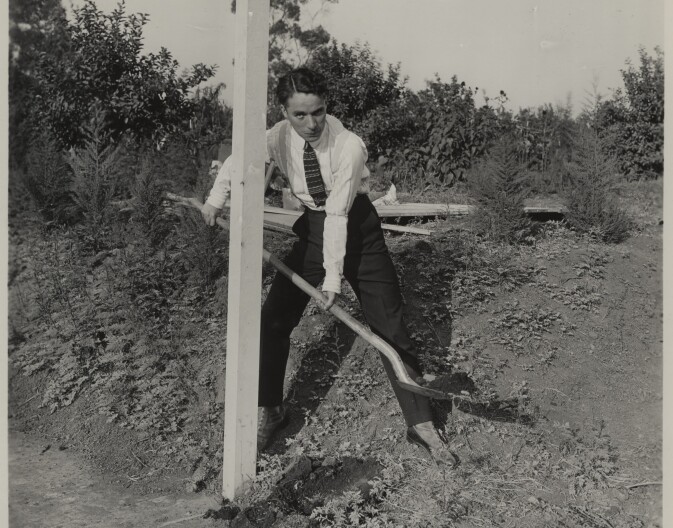
If you’re in Hollywood and drive by the Jim Henson Company lot on La Brea, you can’t miss it: a 12-foot tall Kermit the Frog standing atop the gateway in a too-tight suit, doffing a bowler hat like some character from the silent film era.

It’s a nod to the studio’s storied pre-Muppets past, one that also spans TV and music.
Now the studio is about to start a new chapter. Singer John Mayer and director-producer McG are poised to buy the studio after 25 years of ownership by the Henson Company, which is consolidating production over at its Burbank facility.
A representative for Mayer told LAist in a statement this week that the pair are “under contract” to buy the lot.
The news has created a stir among those who treasure the studio and its contributions to Hollywood.
“When it went on the market, it certainly sparked our interest and potential concern about its future,” said Adrian Scott Fine, president and CEO of the Los Angeles Conservancy.
“It's beloved by many Angelenos,” Fine said. “It's a place that they tend to look forward to seeing when they drive up on La Brea.”
But many passersby might not know how far back the studio’s history goes.
From “The Kid” to the “Red Scare”
The silent film icon Charlie Chaplin built the studio in 1917 amid groves of lemon trees after deciding he wanted to make his films in sunny L.A. and be his own boss.

“As he made more and more films, he wanted more and more independence,” said Arnold Lozano of The Chaplin Office in Paris, which represents his estate. “By 1917, he was able to build his own studio. And he maintained sort of a lone wolf status in Hollywood.”
Chaplin was so excited about having his own studio, he filmed its construction with plans to make a movie about it. It was never released, but here's a compilation of the footage.
It was at the studio where Chaplin made The Kid, The Great Dictator, Modern Times — films that are emulated to this day.
Chaplin was one of the world’s biggest celebs and was visited at the studio by the likes of Helen Keller and Winston Churchill, who toured the 80,000-square foot facility and its massive sound stage.

"It really was a magical place,” Lozano said. “He could transform it into a town in Alaska. It could become the trenches in World War I. Or it became Paris!”
But after more than three decades, Chaplin’s run on La Brea ended. Chaplin was targeted as a communist sympathizer during the Red Scare sweeping the U.S. in the 1950's, despite his denials.
Chaplin was on an ocean liner on the way to a London movie premiere when he received a telegram saying that his return visa had been rescinded, Lozano said. Chaplin decided not to return to live in the U.S.

“He didn't want to have to go before a committee and justify his morals and his politics,” Lozano said.
Pop music’s big night
In 1953, Chaplin sold the studio, and over the next decade it went through a string of owners, including a real estate company, the comedian Red Skelton and CBS.

The studio is where the network shot the courtroom drama “Perry Mason.”
Then in 1966, A&M Records moved in, and built recording spaces used by artists like Carole King, the Carpenters, and Joni Mitchell, who made multiple albums there, including 1971’s “Blue.”
It was during the A&M era, in 1985, when the studio was the scene of one of the biggest moments in pop music history. More than 40 of the world’s top music stars squeezed under one roof for one night to record the charity single “We Are the World.”
Bao Nguyen documented that night for his film “The Greatest Night in Pop” on Netflix. He said many of the singers were meeting for the first time.
“Billy Joel was just really gobsmacked when he met Ray Charles,” Nguyen said. “And a lot of people hadn't met Bob Dylan before.”
Nguyen says the studio on La Brea holds a spot in his heart — not only because he made his film there, but also because of the promise it offers to artists like him.
“What drew me as an East Coaster who always told myself that I would never move to Los Angeles are these sort of relics and artifacts of old Hollywood that draw people in, these artists and dreamers who come to Los Angeles to really follow their passion,” Nguyen said.
What's next
So many memories on this lot. What lies ahead?
Have no fear, you won’t be seeing condos going up. The property is supposed to be protected from that kind of redevelopment by its city-designated status as a Historic-Cultural Monument.
And if John Mayer is one of the studio’s new stewards, preservationists like Fine of the L.A. Conservancy express cautious optimism. Mayer records at the Henson studios and filmed a video there for his song, "Last Train Home."
"There seems to be an affinity and already a connection to this place," Fine said. "I think that's always a positive signal for the future."